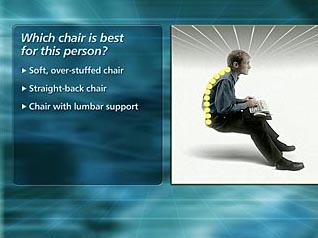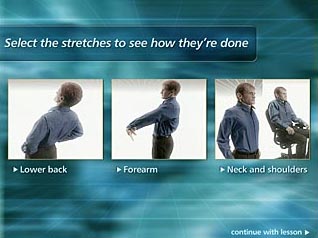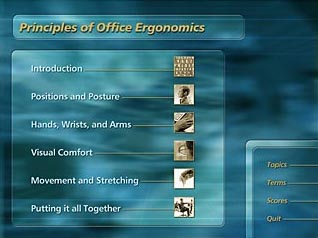Back to Course List
Ergonomics: Principles Of Office Ergonomics
- Product ID
- clmipooe
- Training Time ?
- 33 to 66 minutes
- Language(s)
- English,Dutch (Flemish)
- Video Format
- Standard Definition
- Required Plugins
- MasteryNet Player
- Lesson Interactions
- 13
- Quiz Questions
- 25
- Closed Captioning



Overview
Online training for Office Ergonomics
This training addresses ergonomics issues from the perspective of your employees. Focusing on ergonomically correct body positions, this program offers solutions for how to compensate for workstation limitations and create a healthier and stress-free work environment for your employees.
![]() This course is in the Advantage™ format, to read about Advantage™ features click here.
This course is in the Advantage™ format, to read about Advantage™ features click here.

- Rich multimedia presentation with interactions and quiz
- Print certificate and wallet card
- You have 30 days to complete the course
Workplaces
Categories
Audience
Training for all persons who work in an office or at a job that requires prolonged sitting or operation of equipment such as computers and telephones.
Topics
The course presents the following topical areas:
-
Positions and Posture
- Benefit
- Neutral position
- Bending and twisting
- Sitting
- Lumbar support
- Chair height
- Head and neck position
- Bifocals
- Computer monitor and holding phone
- Arm position
- Arm position, keyboard
- Chair and keyboard adjustments
- Adjusting your workspace
-
Hands Wrists and Arms
- Vulnerability
- Neutral position
- Palm rest
- Mouse, location
- Mouse, hand position
-
Visual Comfort
- Eye strain
- Glare
- Backlighting
- Reflected light
-
Movement and Stretching
- Movement
- Planning your tasks
- Breaks
- Lower back stretch
- Forearm stretch
- Neck and shoulder stretches
- Benefits
-
Putting It All Together
- Your role
- It's up to you
Intended Performance Outcomes
Upon successful completion of this course you will be better prepared to:
-
Use proper body position and posture.
- Explain how to apply ergonomics to individual jobs.
- Explain the benefits of good body position and movement.
- Identify neutral position for the spine while the body is in a sitting position.
- Identify neutral position for standing.
- Identify the natural sight line when the neck is in neutral position.
-
Adjust workspace to improve body position and posture.
- Choose a chair with lumbar support to restore back's S-curve.
- Cite chair height adjustment as solution to pressure on back of legs.
- Cite foot rest as solution to pressure on back of legs while sitting.
- Analyze a head and neck position problem.
- Recommend a solution to a head and neck position problem.
- Recognize adjustments that can improve head and neck position.
-
Use proper hand wrist and arm position and movement.
- Explain why hands and wrists are vulnerable to stress and injury.
- Recognize proper wrist position while typing.
- Describe the proper position for the mouse and mouse pad.
- Identify proper hand and finger position on mouse.
- Relate poor mouse postion to upper back, neck, shoulder and arm pain.
-
Maintain visual comfort.
- Relate glare and poor lighting to eye strain, headaches, and inefficiency.
- Identify the two types of glare that concern us most.
- Choose appropriate solutions for reflected glare problems.
- Choose appropriate solutions for backlight glare problems.
-
Maintain a wide range of motion throughout the day.
- Cite the benefit of building a wide range of motion into our daily lives.
- List ways to improve range of motion during the day.
- Describe how to stretch the lower back.
- Describe how to reduce tightness in the forearm.
- Identify exercises that help reduce tension in the neck and shoulder.
-
Apply ergonomic principles routinely.
- Agree to not ignore discomfort.
- Identify adjustments to the work environment as a means to improve body position and minimize stress.
- Recognize that many small changes can solve problems.
© Mastery Technologies, Inc.




